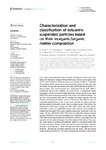Characterization and classification of estuarine suspended particles based on their inorganic/organic matter composition
| dc.contributor.author | Safar, Z | |
| dc.contributor.author | Chassagne, C | |
| dc.contributor.author | Rijnsburger, S | |
| dc.contributor.author | Sanz, MI | |
| dc.contributor.author | Manning, Andrew | |
| dc.contributor.author | Souza, AJ | |
| dc.contributor.author | van Kessel, T | |
| dc.contributor.author | Horner-Devine, A | |
| dc.contributor.author | Flores, R | |
| dc.contributor.author | McKeon, M | |
| dc.contributor.author | Pietrzak, JD | |
| dc.date.accessioned | 2022-10-28T12:51:25Z | |
| dc.date.available | 2022-10-28T12:51:25Z | |
| dc.date.issued | 2022-08-10 | |
| dc.identifier.issn | 2296-7745 | |
| dc.identifier.issn | 2296-7745 | |
| dc.identifier.other | ARTN 896163 | |
| dc.identifier.uri | http://hdl.handle.net/10026.1/19777 | |
| dc.description.abstract |
<jats:p>An 11 hours survey was performed on the 17th of September 2014 in the Rhine Region Of Freshwater Influence (Rhine-ROFI) about 10 km downstream of the mouth of the Rotterdam Waterway during calm weather conditions. Suspended Particle Matter (SPM) measurements were performed during a full tidal cycle, near the seabed, at neap tide, and samples were taken at 0.6 meter above bed for on-board analysis. The measurements were performed with (a) LISST 100X, a submersible particle size analyzer, (b) LISST-HOLO, a submersible digital holographic camera, (c) a home-made underwater camera and (d) an on-board LabSFLOC2 video microscopy equipment that used <jats:italic>in-situ</jats:italic> collected samples. The first aim of the present study was to compare the results obtained from the different monitoring techniques and to characterize the different types of suspended particles found in-situ. It was found that that the highly anisotropic particles present in the water column lead to multiple peaks in the Particle Size Distributions (PSD) found using the LISST 100X. Using the LISST-HOLO, underwater camera and LabSFLOC2 camera these particles could properly be imaged and meaningful PSD’s were obtained using these techniques in the size range &gt; 20 <jats:italic>μ</jats:italic>m. LabSFLOC2, LISST-HOLO and the underwater camera moreover provide information on the size and aspect ratio of particles. On the other hand, LISST 100X can be used to detect the fine fraction (&lt;20 <jats:italic>μ</jats:italic>m), a size range that is not accessible for the other techniques. From the analysis of the data on the survey day, three classes of particles were identified, based on composition rather than size (the sizes given here are purely indicative): (1) mineral (inorganic) sediment particles in the range size 5 - 20 <jats:italic>μ</jats:italic>m, (2) organic/inorganic aggregates in the size range 20 - 200 <jats:italic>μ</jats:italic>m and (3) organic particles in the size range &gt; 200 <jats:italic>μ</jats:italic>m. A large range of settling velocities (0.1 - 10 mm/s) and aspect ratios between 1 and 10 were recorded by video microscopy (LabSFLOC2). This spreading in settling velocities and aspect ratio was due to the different properties (shape, effective density and size) of the particles in the water column. The second aim of the study was to reproduce the flocs found <jats:italic>in-situ</jats:italic> in the lab and investigate the kinetics of flocculation between inorganic and living organic matter. Laboratory experiments were conducted with grab samples obtained from Port of Rotterdam harbour and living microalgae (<jats:italic>Skeletonema costatum</jats:italic>). The results of these experiments showed a shift in effective density upon addition of living algae to the sediment, which confirmed the flocculation ability between sediment and microalgae. The flocculation occured on a timescale of minutes and lead to flocs having a large spread in density for a given size, due to the heteregeous inorganic/organic composition of the flocs. This spread in density was at the origin of the large range of settling velocities for a given floc size observed in-situ, which leads to conclude that organic matter should be an important input parameter in sediment transport models.</jats:p> | |
| dc.format.extent | 896163- | |
| dc.language.iso | en | |
| dc.publisher | Frontiers Media | |
| dc.subject | Flocculation | |
| dc.subject | SPM | |
| dc.subject | ROFI | |
| dc.subject | aggregation | |
| dc.subject | algae | |
| dc.subject | settling velocity | |
| dc.subject | density | |
| dc.title | Characterization and classification of estuarine suspended particles based on their inorganic/organic matter composition | |
| dc.type | journal-article | |
| dc.type | Journal Article | |
| plymouth.author-url | https://www.webofscience.com/api/gateway?GWVersion=2&SrcApp=PARTNER_APP&SrcAuth=LinksAMR&KeyUT=WOS:000844355300001&DestLinkType=FullRecord&DestApp=ALL_WOS&UsrCustomerID=11bb513d99f797142bcfeffcc58ea008 | |
| plymouth.volume | 9 | |
| plymouth.publication-status | Published online | |
| plymouth.journal | Frontiers in Marine Science | |
| dc.identifier.doi | 10.3389/fmars.2022.896163 | |
| plymouth.organisational-group | /Plymouth | |
| plymouth.organisational-group | /Plymouth/Faculty of Science and Engineering | |
| plymouth.organisational-group | /Plymouth/Faculty of Science and Engineering/School of Biological and Marine Sciences | |
| plymouth.organisational-group | /Plymouth/REF 2021 Researchers by UoA | |
| plymouth.organisational-group | /Plymouth/REF 2021 Researchers by UoA/UoA07 Earth Systems and Environmental Sciences | |
| plymouth.organisational-group | /Plymouth/Research Groups | |
| plymouth.organisational-group | /Plymouth/Research Groups/Marine Institute | |
| plymouth.organisational-group | /Plymouth/Users by role | |
| plymouth.organisational-group | /Plymouth/Users by role/Academics | |
| dcterms.dateAccepted | 2022-06-29 | |
| dc.rights.embargodate | 2022-10-29 | |
| dc.identifier.eissn | 2296-7745 | |
| dc.rights.embargoperiod | Not known | |
| rioxxterms.versionofrecord | 10.3389/fmars.2022.896163 | |
| rioxxterms.licenseref.uri | http://www.rioxx.net/licenses/all-rights-reserved | |
| rioxxterms.type | Journal Article/Review |


